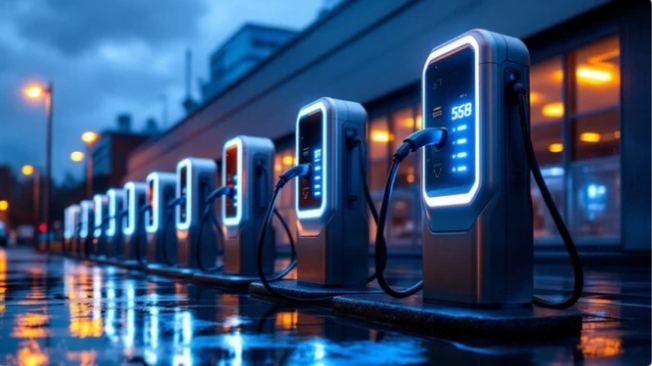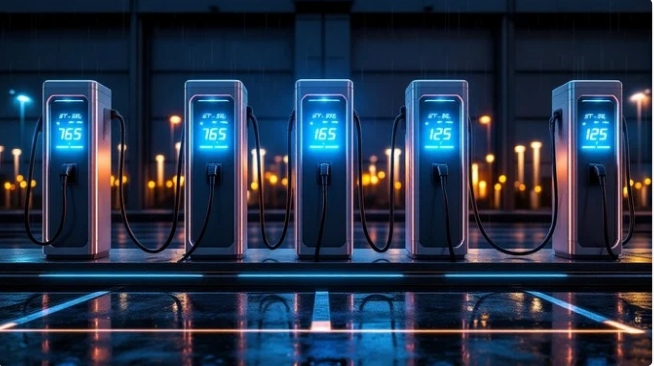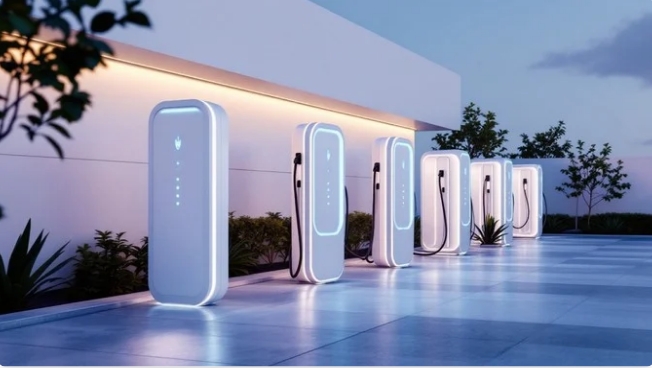
Electric Vehicle (EV) charging displays are a critical component of modern EV infrastructure. These displays provide users with essential information about the charging process, including the status of the charge, estimated time, and any operational issues. They are designed to be user-friendly, reliable, and durable, ensuring that EV owners have a seamless charging experience. The features of EV charging displays are designed to enhance the ease of use, communication, and efficiency of the entire EV charging process.
Key Features of Electric Vehicle Charging Displays
1. Clear and Informative Visual Feedback
· Charging Status Indicators: EV charging displays often show the current charging status, such as charging in progress, fully charged, error, or paused. This is typically represented by icons, LED lights, or text that change color or animation based on the charging process.
· Progress Bar or Percentage: Displays commonly include a progress bar or percentage indicator to show how much charge has been added to the vehicle’s battery. This gives users a visual representation of the charging progress.
· Estimated Charging Time: Many EV charging stations provide an estimated time to full charge based on the current charging rate and the vehicle's battery capacity. This helps users plan their time more effectively.
2. High-Visibility and Readability
· High Brightness for Outdoor Use: EV charging displays must be readable in various lighting conditions, especially in outdoor environments or parking lots. High-brightness LCD or LED screens (typically over 1000 nits) are used to ensure visibility even in direct sunlight.
· Wide Viewing Angles: Displays are designed to offer wide viewing angles (up to 170° or more), ensuring that users can read the information clearly from different positions around the charging station.
· Anti-Glare Coating: To ensure readability in bright environments, anti-glare or anti-reflective coatings are often applied to the screens, reducing reflections from ambient light.
3. User Interface (UI) and Interaction
· Touchscreen Functionality: Many modern EV chargers are equipped with touchscreen displays, allowing users to interact with the charging station. These screens can be used for starting or stopping the charge, selecting payment methods, or viewing additional information like pricing and station availability.
· Simple Navigation: The user interface is typically designed to be intuitive and easy to navigate, offering clear options like start charging, stop charging, view station details, and payment processing.
· Multi-Language Support: To cater to a global audience, many EV charging displays support multiple languages, allowing users to select their preferred language for the instructions and information.
4. Real-Time Data and Communication
· Real-Time Charging Data: EV charging displays provide real-time data such as voltage, current, power consumption, and charging speed. This helps users monitor the efficiency of the charging process.
· Connectivity to EV Network: Some charging stations are connected to central systems via cloud-based platforms or local networks. This allows for remote monitoring, updates, and error reporting, and ensures that users can receive notifications regarding the status of the station or charging process.
· Status Alerts: Displays may show error codes or warnings if there are issues with the charging process, such as a connection error, insufficient power supply, or a malfunction in the charging hardware.
5. Payment Integration
· Payment Display and Processing: Many EV chargers include a payment interface on the display, allowing users to view the cost of charging and complete the transaction. Payment options typically include credit cards, mobile wallets, and contactless payments.
· Pricing Information: Charging stations may show real-time pricing or a rate breakdown for users, which could include options like per kWh, per minute, or subscription plans.
· Transaction Confirmation: Once payment is processed, the display provides confirmation of the transaction and the charging start. Some systems also display receipt options, which can be emailed or printed for user records.
6. Safety and Compliance Information
· Safety Warnings and Instructions: EV charging displays often include safety information such as warnings about electric shock risks, instructions on how to connect/disconnect the vehicle, and emergency contact details in case of malfunction.
· Regulatory Compliance: EV charging stations are subject to local and international standards. Displays may indicate compliance with safety certifications and ensure that the system is operating within regulated limits (such as UL certification or IEC standards).
· Emergency Stop Functionality: Some systems feature an emergency stop button on the display, allowing users to immediately halt the charging process in case of an issue.
7. Energy and Environmental Metrics
· Energy Consumption: EV charging stations can display the total energy consumed during the charging session, usually in kWh (kilowatt-hours). This data helps users track their electricity use and can be useful for billing purposes.
· Carbon Offset Information: In some cases, charging stations equipped with renewable energy sources (such as solar or wind power) may display the environmental benefits of using clean energy, such as the amount of CO2 offset by charging with renewable sources.
· Efficiency Metrics: Displays may show the efficiency of the charging process, indicating how much energy was delivered to the vehicle's battery versus what was drawn from the grid.
8. Remote Monitoring and Diagnostics
· Real-Time Monitoring: Charging stations often have remote monitoring capabilities that allow operators to view the status of the station, track usage, perform diagnostics, and resolve issues without physically being at the location.
· Fault Detection and Alerts: If a problem arises during charging, the display may show error messages or alert users and operators about technical issues, such as power failure, hardware malfunction, or connection problems.
· Firmware Updates: Some EV charging stations are capable of automatic firmware updates or remote troubleshooting to ensure the display and charging hardware remain up-to-date.
9. Accessibility Features
· Voice Assistance: Some EV chargers may include voice interaction features or audio cues for accessibility purposes, providing information for users who may have visual impairments.
· Text-to-Speech: To make the station more user-friendly, especially for people with disabilities, some charging displays provide text-to-speech functionality for the visually impaired.
· Adjustable Display Height: To accommodate all users, including those in wheelchairs, the height of the display and controls may be adjustable or positioned for easy access.
10. Durability and Weatherproofing
· Weather Resistance (IP Rating): EV charging displays must be built to withstand the elements, particularly if installed in outdoor settings. IP65, IP67, or IP68 ratings are common to protect against dust, rain, and harsh weather conditions.
· Impact-Resistant Glass: To prevent damage from accidental impacts or vandalism, displays often feature hardened, impact-resistant glass or polycarbonate materials.
11. Energy-Saving Features
· Low Power Consumption: Displays are designed to be energy-efficient, minimizing their power use when idle or during low activity. Features such as automatic brightness adjustment based on ambient light conditions or sleep modes help conserve energy when the station is not in active use.
· Energy Saving Mode: In some cases, when a vehicle is fully charged or when the station is not in use, the display will automatically enter low-power mode to reduce energy consumption.
Applications of Electric Vehicle Charging Displays
Public Charging Stations:
o At public EV charging stations, displays show essential information for users such as charging progress, payment options, price breakdown, and real-time availability of chargers. They also ensure safety instructions and error messages are visible.
Home Charging Stations:
o Some home EV chargers include smaller displays or companion apps to provide information on the charging process, energy consumption, and costs.
Fleet Charging Stations:
o Fleet operators may use EV charging displays to monitor and manage multiple vehicles, track energy usage, and perform diagnostics on the charging systems, often from a central monitoring system.
Workplace Charging:
o Employee EV charging stations often provide personalized information, allowing workers to see when their vehicle will be fully charged and whether a charging station is available for use.
Mobile EV Charging Units:
o Some mobile EV charging solutions use compact displays to offer essential charging information, especially for emergency or roadside assistance scenarios.

Conclusion
EV charging displays serve as a critical interface between users and the charging infrastructure, providing essential information, ensuring ease of use, and promoting safety during the charging process. Key features such as high visibility, user-friendly interfaces, real-time data, payment integration, and environmental metrics enhance the overall charging experience and facilitate the transition to more widespread electric vehicle adoption.
Let me know if you'd like more detailed information about specific types of displays or technologies!
Electric Vehicle Charging Display Custom LCD Solutions for Diverse Applications
Brightness from 0-3000 for perfect display effect achievement. 100% NTSC makes the vividness of the picture better and the color transition in the picture more natural. Color Temperature is positive white at around 5500K, warm white (yellowish) at 3500K and also cool white (cold) at 6500K. Driver circuit with sufficient voltage and current values to meet output requirements and reduce the secondary development cycle. Heat dissipation for high-brightness products to advance design of reasonable heat dissipation structure.Power consumption, we increase the brightness without increasing the power consumption. Cables, Backlighting also requires cables, either through an FPC connected to the LCD's FPC and controlled through a port, or a separate cable that controls it through a connector. LED life reached the standard of 30K hours Min. 50K, 70K, 100K hours are all achievable.

Electric Vehicle Charging Display Touch screen,standard type and customization

Electric Vehicle Charging Display Driver board/adapter board, standard type and design customization
DEMO board, H-DMl board, other customized board, etc.

Electric Vehicle Charging Display Embedded Integrated Solution
UART display solution, H-DMl display solution, Window display solution, Android display solution, Raspberry Pi solution, portable secondary screen solution, etc.